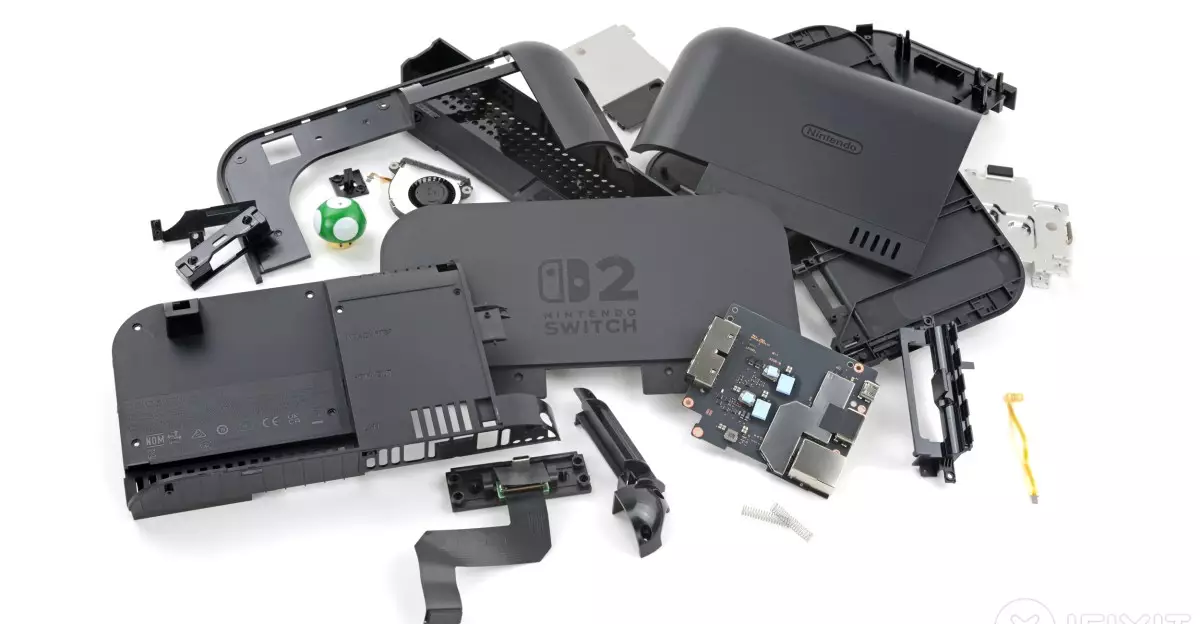Nintendo has long been a beloved name in gaming, known for innovation and creativity. However, their approach to hardware repairability raises significant concerns, especially with the newly released Switch 2. Recent reports from iFixit, a well-respected repair advocacy group, illuminate a troubling reality: the Switch 2 has not only maintained issues observed in its predecessor but also compounded them, leading to an abysmal repairability score of 3 out of 10. In an era where sustainability and consumer rights are increasingly prioritized, it’s disheartening to see such a step backward in design philosophy.
The teardown analysis highlights a myriad of components that are unnecessarily difficult to access or replace. Critical parts, like the battery and flash storage modules, are glued or soldered in place—an design choice that blatantly undermines the user’s ability to maintain their own device. This practice is alarmingly prevalent; as if the company is sending a message that repairs should be avoided at all costs. The very tools that consumers once had to repair their devices seem progressively inadequate against the growing complexity embedded in these systems.
The Hidden Challenges of Repairing the Switch 2
One major finding from the teardown is the persistent use of tri-point screws, a move that many argue serves no purpose other than to limit access to internal components. Many of these screws are concealed beneath stickers, which upon removal, typically damage the surface and risk compromising the aesthetic integrity of the console. This design decision not only frustrates DIY enthusiasts but introduces an unnecessary barrier for routine maintenance. Moreover, the company has never provided repair manuals or parts for previous devices, raising further alarm over the future of self-repair for customers.
It’s particularly troubling that while certain components like the headphone jack and speakers remain relatively easy to replace, fundamental repairs—such as battery swaps—are described as an “absolute mission.” The glue used in securing the battery is intense, requiring copious amounts of isopropyl alcohol and specialized tools, which some average consumers may not even possess. This creates a scenario where a simple battery replacement could deter gamers from attempting repairs altogether, forcing them into the company’s support system, where costs and time may skyrocket.
A Growing Problem: The Joystick Drift Dilemma
The Switch 2 arrives at a time when joystick drift—the phenomenon where controllers register movement without any input—has plagued its predecessor. Despite understanding this issue, Nintendo has opted for the same potentiometer technology in the new Joy-Cons. The potential for drift remains high, yet repairing this issue has become increasingly complicated with the Switch 2. Given the difficulty in disassembling the new controller, users may find themselves resigned to purchasing new Joy-Cons rather than enduring the hassle of repairs.
Nintendo seems to prioritize sleek design and modern aesthetics over functionality and user agency, a trend that is not only frustrating but increasingly outdated. We live in an age where users demand transparency,,
The Broader Implications of Limited Repairability
The ramifications of this design approach extend far beyond individual frustrations; they illustrate a deeper malaise within the tech industry, where manufacturers continually prioritize profits over consumer empowerment. In a world grappling with issues of waste and sustainability, the inability to easily repair devices contributes to a culture of disposability, contradicting the ideals of recycling and environmental consciousness.
Nintendo fans must grapple with the stark choice posed by the Switch 2: accept a device that is functionally enjoyable yet burdensome to repair, or conform to the outdated cycle of frequent replacements and wasteful consumption. As consumers become increasingly aware of their rights and the environmental impact of electronics, it is essential for brands like Nintendo to adapt and change course. Otherwise, the love and loyalty garnered over decades could wane, as consumers seek more repair-friendly options in a market that is becoming increasingly aware of its own complexities.
Ultimately, the Switch 2’s design choices challenge the goodwill that Nintendo has built over the decades. As we move forward, a broader push for repairability and innovation that respects both consumer rights and the environment should supersede the short-term gains offered by restrictive design tactics. The gaming community deserves better, and it’s time for Nintendo to heed that call.


Leave a Reply